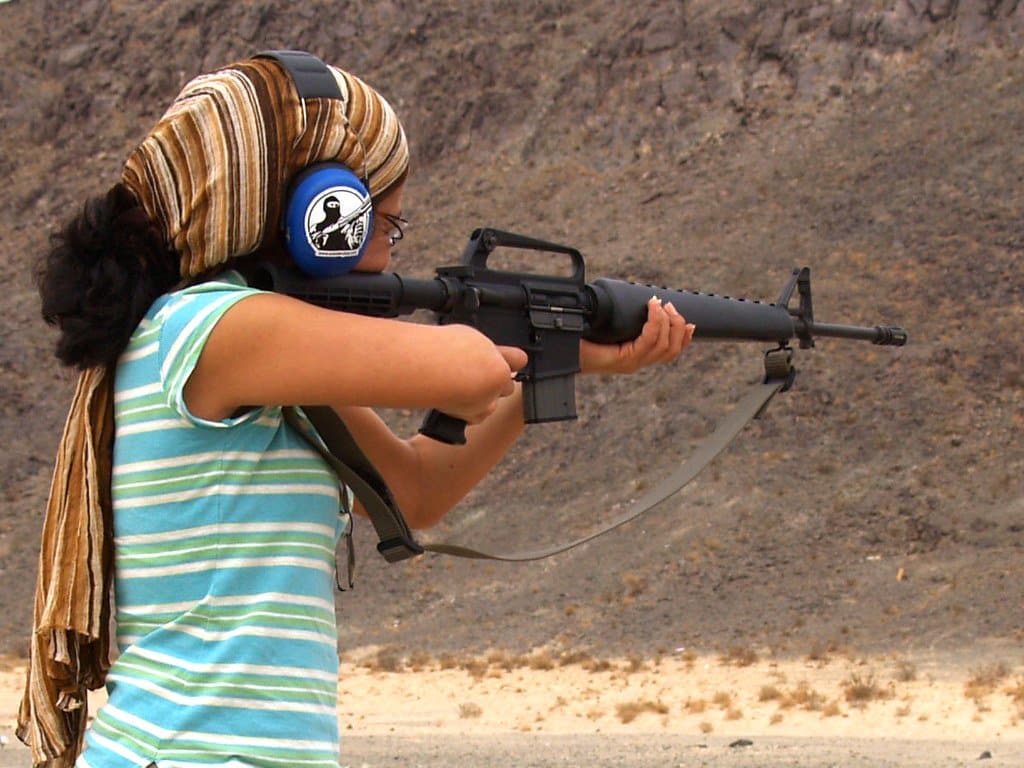On Friday, a federal judge struck down California’s assault weapon ban in Miller v. Bonta. In the nearly 100-page opinion, District Court Judge Roger Benitez dissected post-Heller Second Amendment jurisdiction, while scrutinizing the state’s claimed justification for banning ownership of so-called “assault weapons,” before enjoining enforcement of several sections of California’s Assault Weapons Control Act (AWCA). Yet for 30 days Judge Benitez also stayed the execution of the declaratory judgment and permanent injunction to allow the named defendant, California Attorney General Rob Bonta, to appeal.
In striking down California’s “assault weapon” ban, which criminalizes the possession of various semi-automatic weapons based on their appearance, features, or ability to hold a magazine with more than 10 rounds of ammunition, Judge Benitez conducted a thorough review of controlling Second Amendment precedent and analyzed the hefty evidentiary record. He began with Heller, in which the Supreme Court noted the Second Amendment’s guarantee of the right to bear arms extends to firearms commonly owned by law-abiding citizens for lawful purposes, as opposed to weapons predominately used only in military settings.
Judges Ignoring Supreme Court Gun Protections
The Heller test, Judge Benitez noted, is a “hardware test,” but since Heller, the federal appellate courts have ignored this simple holding and created an array of various standards under which to judge the constitutionality of laws regulating firearms. Before applying the two-prong test the Ninth Circuit invented, though, Judge Benitez laid out how California’s law would fare under a straightforward application of Heller. In the process, he revealed some statistics of which most Americans are likely ignorant.
“Modern rifles have become immensely popular in the United States. Even in California, despite being banned for 20 to 30 years, according to the State’s own evidence, there are 185,569 ‘assault weapons’ currently registered with California,” with another 50,000-plus assault weapon registrations backlogged. Nationally, while possession of an “assault weapon”—rebranded “modern rifles” in the opinion to separate the emotive response from the rationale—is legal in all but six states, “modern rifles are ubiquitous.”
“In 2018 alone (the most recent year with data), 1,954,000 modern rifles were manufactured or imported into the United States,” the statistics show, while “[o]ver the last three decades, 19,797,000 modern rifles have been manufactured or imported into the United States and the numbers have been steadily increasing,” and [a]lmost one-half of all rifles (48%) produced in 2018 were modern rifles.” Benitez provided more details before crystalizing his point by noting that in 2018, more than twice as many modern rifles were sold than Ford F-150s.
Even By Ninth Circuit Rules, a Ban Is Unconstitutional
Under the Heller test, this record establishes the unconstitutionality of the ban on assault weapons, Benitez concluded. However, being bound by Ninth Circuit precedent, Benitez continued to consider the constitutionality of California’s law under that appellate court’s two-prong test. In his analysis, Benitez bypassed the strict scrutiny standard, noting in passing the law would fail that test as well, to apply the “intermediate scrutiny standard” created by the Ninth Circuit.
Under that standard, a law affecting the right to bear arms is constitutional if the government proffers an “important” governmental purpose, and its “fit” of the law to the objective is reasonable. “As always, the State’s objective with these laws (i.e., to reduce gun crime) passes the first prong of the test,” Judge Benitez wrote, noting that reducing gun crime is a very important objective. But after a detailed analysis, the court concluded California’s assault-weapon ban lacked a reasonable “fit” to that goal.
Benitez observed “the ‘assault weapon’ epithet is a bit of a misnomer. These prohibited guns, like all guns, are dangerous weapons. However, these prohibited guns, like all guns, can be used for ill or for good. They could just as well be called ‘home defense rifles’ or ‘anti-crime guns.’” He added that in criminalizing certain firearm features, California branded as “assault weapons” “certain shotguns and pistols, and (recently) guns that are neither rifles, nor shotguns, nor pistols.”
He also stressed initially that that since 1989, when California first passed its Assault Weapons Control Act, the understanding of the Second Amendment has changed substantially. At that time, the California legislature focused on a firearm’s value only “for sports and recreation,” but as the Supreme Court in Heller and McDonald made clear, “individual self-defense is ‘the central component’ of the Second Amendment right.”
Thus, in adopting the ban on “assault weapons,” “the California Legislature neither mentioned a modern rifle as a means of self-defense, nor did the core Second Amendment right appear to have been any part of its consideration. The formal legislative findings say nothing about self-defense.”
Ignoring the Protective Uses of Guns
California’s continuing lack of respect for an individual’s right to self-defense resounded throughout the arguments the state attorney general made in the district court. In arguing for the constitutionality of the ban, Bonta ignored the countervailing interest of law-abiding citizens to protect themselves and their families. Instead, the state portrayed the assault weapons ban as a panacea to mass shootings. Since “assault weapons” are so accurate and allow for the discharge of multiple bullets, they prove ideal for mass shootings, the state argued.
But this rationale, Judge Benitez established in his opinion, ignores that, “in the self-defense context, which seems to be more common, taking accurate shots at attackers is vitally important for the innocent victim.” Thus, “[w]hile the state ought to protect its residents against victimization by a mass shooter, it ought also to protect its residents against victimization by home-invading criminals,” the district court judge stressed.
California, however, seems to view armed citizens defending themselves differently than the Founders did, with Benitez noting that “the State’s litigation stance is more like the view recently expressed by a police chief in Oakland, California: we do not want victims to arm themselves; we want them to be good witnesses.” “Of course, a dead victim is a lousy witness,” he added.
Yet, as Benitez detailed in his opinion, “there is clear evidence that AR-15 rifles are and have been used for self-defense.”
For example, in one case an AR-15 was used in Florida by a pregnant wife and mother to defend her family from two armed, hooded, and masked home intruders. As soon as the armed intruders entered the back door of her home, they pistol-whipped her husband — fracturing his eye socket and sinus cavity. Then they grabbed the 11-year-old daughter. Before they could do any more harm, the pregnant wife retrieved the family AR-15 from a bedroom and fired, killing one of the attackers while the other fled. It does not require much imagination to guess what would have happened next if the wife and mother did not have the firearm, or if she had emptied the AR-15’s magazine before the attackers had fled.
Benitez also found the evidence failed to support the state’s purported rationale, because “a less accurate rifle in the hands of a mass shooter may very well result in different victims, but not necessarily fewer victims.” Also, contrary to the California legislature’s prediction in 1989 that “an assault weapons ban would eliminate or reduce mass shootings[,] it has not turned out that way.” Instead, “mass shootings with assault weapons continue to occur at the same average rate as before the ban.”
Guns Don’t Cause Crime; Criminals Do
In fact, as Judge Benitez exposed, the California attorney general’s assertion “that modern rifles are disproportionally used in crime” is not supported by the evidence. On the contrary, at the time the Supreme Court handed down the landmark Second Amendment decisions, “81% of firearm-homicide victims were killed by handgun.”
The opinion also eviscerated the studies California relied upon as evidence of the use of assault weapons in mass shootings. For instance, in one study an expert defined a “gun massacre” “as a shooting event resulting in at least six deaths and where at least one assault weapon was discharged.” “The definition,” Benitez explained, “almost creates a tautology along the lines of assault weapons are used disproportionately in assault weapon events.” That study and another, Judge Benitez stressed, wrongly focus on mass shootings, as opposed to crimes in general.
Even then, Benitez found the evidence established that “assault rifles were not the predominant type of weapon used” in mass shootings. “In fact, according to a recent study, handguns were the most used type of firearm in mass shootings (32.99% of mass shootings); rifles were used in only 8.25% of mass shootings.” “That may come as a surprise to the public that is constantly told that assault weapons are often used in mass shootings,” Benitez added.
In short, the court found the prohibited features that under the law “convert” a firearm into an illegal “assault weapon” “do not change an AR-15 rifle from a benign weapon into an ‘incredibly effective killing machine.’” Here, Benitez highlighted a short video entered into evidence in which “two AR-15 type rifles were fired repeatedly and reloaded with a detachable magazine at a target. One rifle had all of the prohibited features prohibited by [California’s law]. The other rifle was a ‘featureless’ California-legal variety of AR-15 rifle. The results were remarkably similar. Each rifle fired at approximately the same speed and accuracy. Any difference was hardly noticeable.”
While the state argued this similarity in performance established the ban did not interfere with the plaintiffs’ Second Amendment rights because they could just purchase the “featureless” AR-15 rifle, in reality this evidence showed the ridiculousness of the California law. The ban on “assault weapons” does nothing but create a false sense that the government cares and can prevent the horrifying scenes of mass shootings.
On the Way to the Supreme Court
Bonta and California Gov. Gavin Newsom have vowed to appeal Benitez’s decision. With the appeal destined for the Ninth Circuit Court of Appeals, reversal seems certain, either by a three-judge panel or later in an en banc hearing before 11 judges of the leftist court. The Ninth Circuit, however, merely serves as the stepping-stone for the ultimate destination of the Miller case: the U.S. Supreme Court.
Although so far the Supreme Court has steadfastly refused to hear appeals from other circuits concerning the constitutionality of “assault weapon” bans, the justices’ hands-off approach to Second Amendment cases has recently changed. For the first time in more than a decade the high court recently agreed to hear a Second Amendment case in New York State Rifle & Pistol Association, Inc. v. Corlett. That case concerns the constitutionality of New York’s concealed-carry licensing scheme that, in essence, limits the right to keep and bear arms to citizens’ homes.
Getting Miller to the Supreme Court will be equally important, as that case concerns much more than the question of the constitutionality of “assault weapon” bans: It squarely presents an issue dividing the circuit courts, the appropriate standard for reviewing laws that affect Second Amendment rights. Here, Benitez’s 94-page opinion provides a perfect primer for Americans seeking to understand both the law and the fallacies pushed by politicians and the press to justify infringements on Second Amendment rights.
Corporate Press Lies to Help Democrats
Although Benitez’s detailed analysis of Second Amendment jurisprudence should serve as the more important takeaway from Friday’s decision, as coverage of the decision has already shown, when guns are involved, the narrative and public opinion prove key. That same coverage proves a second corollary: When guns are subject, the left-leaning press serves as a propaganda arm of the Democratic Party.
“Federal judge overturns California’s ban on assault weapons and likens AR-15 to Swiss Army knife,” a CNN headline read, parroting Newsom’s talking point. “This judge compared the AR-15 – a weapon of war that’s used on the battlefield – to a Swiss Army Knife [and that comparison] completely undermines the credibility of this decision and is a slap in the face to the families who’ve lost loved ones to this weapon,” the embattled California governor said in a press release.
Bonta likewise ignored the depth of the nearly 100-page opinion to intone “there is no sound basis in law, fact, or common sense for equating assault rifles with swiss army knives — especially on Gun Violence Awareness Day and after the recent shootings in our own California communities,” in a news release issued shortly after the opinion dropped.
CNN added to its coverage the statement from activist Fred Guttenberg, who lost his daughter in a shooting in 2018: “My daughter is in a cemetery because a Swiss Army Knife was not used, because it was an AR-15. If a Swiss Army Knife were used, my daughter and most of those other kids and adults would be alive today.”
The Washington Post, USA Today, and virtually every legacy outlet ran the same spin. And spin it was because Judge Benitez’s opener, noting that “like the Swiss Army Knife, the popular AR-15 rifle is a perfect combination of home defense weapon and homeland defense equipment,” provided but a simple illustration of a minor point the long-time federal judge made later: that merely because a civilian rifle has characteristics that are useful in the military “does not detract from the constitutional protection afforded for self-defense.”
Bodies Kill More than Guns Do
But instead of delving into Benitez’s reasoning, the corrupt media constructed a Swiss strawman to torch, ignoring both the federal judge’s analysis and the many press-peddled urban legends about “assault weapons” Benitez countered. In fact, most of the media ignore the larger point Benitez made concerning knives, namely that murderers use knives much more often than they do any kind of rifle.
“Federal Bureau of Investigation murder statistics do not track assault rifles, but they do show that killing by knife attack is far more common than murder by any kind of rifle,” Benitez noted. In fact, “[i]n California, murder by knife occurs seven times more often than murder by rifle,” with California seeing 252 people murdered with a knife in 2019, compared to “34 people were killed with some type of rifle – not necessarily an AR-15.” “In 2018,” he continued, “the statistics were even more lopsided as California saw only 24 murders by some type of rifle. The same pattern can be observed across the nation.”
These statistics, and the fact that “a Californian is three times more likely to be murdered by an attacker’s bare hands, fists, or feet, than by his rifle,” Judge Benitez noted, show that “news media and others” who portray our nation as “awash with murderous AR-15 assault rifles,” push hyperbole. Still, “facts matter,” the George W. Bush appointee stressed. But apparently not to Second Amendment deniers who caricatured Benitez’s opinion instead of reporting the facts and the law underlying his ruling.






